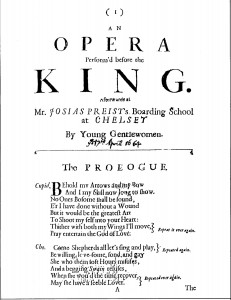The Revised Version of Venus and Adonis
In this excerpt adapted from the Introduction of the Purcell Society’s edition of John Blow’s Venus and Adonis, Bruce Wood describes the revision process undertaken by the composer at some point after the orginal performance at Court and production at Josias Priest’s boarding school in Chelsea, the one documented performance of the opera. It is the revised version described here that Magnificat will be presenting in our concert on the weekend of October 8-10.
 At some point after the Chelsea performances, Blow subjected the score of Venus and Adonis to further and more extensive reworking; the fact that there were at least two phases of revision indicates that instead of going to the trouble of recopying the score, he simply altered the existing autograph, and it seems likely that at one or two points he entered a revised reading without deleting the original one, leaving his intentions unclear. The most substantial change is that the entire sequence of courtly dances at the end of Act II is cut, severing the work from the masquing tradition that had given birth to it. Also cut is a short linking passage for continuo just before the final lament, though elsewhere a similar link is inserted; a short echo phrase for continuo only and an extra bar are inserted into the dialogue between Venus and Adonis in Act I, and a couple of bars into the Tune for Flutes at the end of the Prologue.
At some point after the Chelsea performances, Blow subjected the score of Venus and Adonis to further and more extensive reworking; the fact that there were at least two phases of revision indicates that instead of going to the trouble of recopying the score, he simply altered the existing autograph, and it seems likely that at one or two points he entered a revised reading without deleting the original one, leaving his intentions unclear. The most substantial change is that the entire sequence of courtly dances at the end of Act II is cut, severing the work from the masquing tradition that had given birth to it. Also cut is a short linking passage for continuo just before the final lament, though elsewhere a similar link is inserted; a short echo phrase for continuo only and an extra bar are inserted into the dialogue between Venus and Adonis in Act I, and a couple of bars into the Tune for Flutes at the end of the Prologue.
Revisions affecting detail rather than structure are very much more numerous, and include the recasting of the inner parts at several points in the Overture, and of the second violin part of one passage in Act I; the addition of an instrumental obbligato part; the transfer of lines between voices, or between a vocal and an instrumental part; a straightforward interchange of vocal parts; the removal, in a couple of places, of a notated upper part apparently intended for harpsichord and echoing a vocal phrase; and a small but telling intensification in the final statement of a rondo theme. There are innumerable changes, nearly all of them tiny, to rhythmic detail, melodic outline (including the inclusion or omission of ornaments) and underlay, and shifts of octave in the basso continuo. In addition to these adjustments, doubling of voices by instruments in most of the chorus passages – something which is left implicit in the original version – is specified by means of verbal directions or, in places, written out in full.
The extent of the revisions diminishes markedly towards the end, and throughout the work the motivation for individual changes, like those in other scores which Blow subjected to revision, is sometimes less than obvious. The structural alterations, nevertheless, are readily explicable as reflecting the requirements of production in a different context and on a different stage from those originally envisaged, whilst many of the lesser changes amount to simplification of detail, presumably intended to suit the work to a larger venue. Unfortunately, no evidence survives of any production after the one in Chelsea.
Once Blow’s score had reached its final state it was recopied by William Isaack, a clerk of Eton College from 1673 until his death in 1703. He did this, presumably, so that it could be used once again for directing from the harpsichord: the alterations make the manuscript very difficult to read in places, but few of them affect the continuo bass line. The implication is that the revised version of the work did indeed go into production, even though we know nothing of when or where. It would be tempting to surmise that the revision was somehow linked with Blow’s plans for an “Academy or Opera of Musick”, but for the fact that Isaack’s score appears to date from the 1690s, not the 1680s.